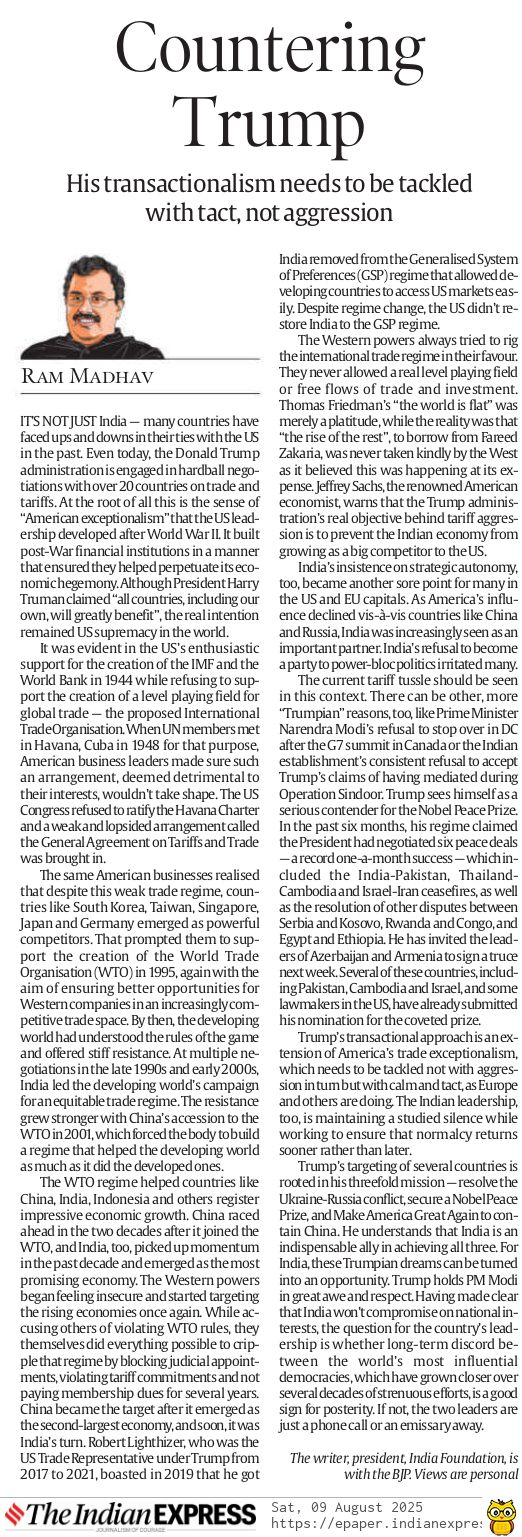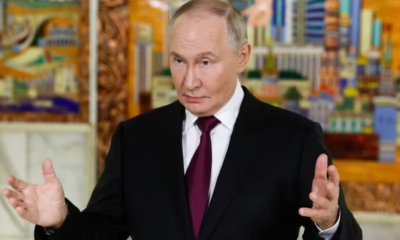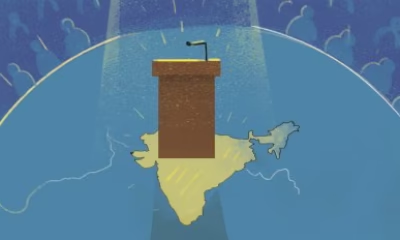
|
Getting your Trinity Audio player ready...
|
(The article was originally published in Indian Express on August 09, 2025 as a part of Dr Madhav’s column titled ‘Ram Rajya’. Views expressed are personal.)
The US-India relations have seen many ups and downs in the past. Not just India, but many other countries faced similar situations. Even today, the Trump regime is engaged in hardball negations with over 20 countries on trade and tariffs. At the root of all this is the sense of “American exceptionalism”, that the US leadership developed after the victory in the 2nd World War. It built post-War financial institutions in a manner that they helped perpetuate its economic hegemony. Although President Harry Truman claimed that “all countries, including our own, will greatly benefit”, the real intention remained US’ supremacy in the world.
It was evident in their enthusiastic support for the creation of the IMF and World Bank in 1944 but their refusal to support the creation of a level playing field for global trade in the form of the International Trade Organization (ITO). When the UN member countries met at Havana in Cuba in 1948 for that purpose, American business leaders descended in hordes at the venue and made sure that such an arrangement, deemed detrimental to their interests, wouldn’t take shape. The Havana Charter was rejected and a weak and lopsided arrangement called the General Agreement in Trade and Tariffs (GATT) was brought in.
But the same American businesses realized that, despite that weak trade regime, countries like South Korea, Japan, Taiwan and Singapore – Asian Tigers – and Germany grew powerful and emerged as competitors to them. That prompted them to support the creation of the World Trade Organization (WTO) in January 1995, again with the deceptive aim of ensuring better opportunities for Western companies in an increasingly competitive trade space. By then, the developing world had understood the rules of the game and put up a stiff resistance. At multiple rounds of trade negotiations in late 1990s and early 2000s, India led the developing world’s campaign for an equitable trade regime. The resistance grew stronger with the joining of China in WTO in 2001, which forced the body to build a regime that helped the developing world as much as it did for the developed ones.
The WTO regime helped countries like China, India, Indonesia and others to register impressive economic growth. China raced ahead in the two decades after joining the WTO, and India too picked up momentum in the last decade and emerged as the most promising economy. The Western powers began feeling insecure and started targeting the rising economies once again. While accusing others of violating WTO rules, they themselves did everything possible to cripple that regime by blocking judicial appointments, violating tariff commitments and not paying membership dues for several years. China became the target after it emerged as the 2nd largest economy in 2008. A decade later, it was India’s turn. Robert Lighthizer, who served as US Trade Representative under President Trump during 2017-20, boasted in 2019 that he got India removed from the Generalized System of Preferences (GSP) regime that allowed developing countries to access US markets easily. Despite regime change, the US didn’t restore India to the GSP regime.
Basically, the Western powers always tried to rig the international trade regime in their favor. They never allowed real level playing field or free flows of trade and investments. Thomas Freidman’s “world is flat” was merely a platitude, while the reality was that “the rise of the rest”, to borrow from Fareed Zakaria, was never taken kindly by the West as they believed that it was happening at their expense. Jeffrey Sachs, renowned American economist, warns that the Trump regime’s real objective behind tariff aggression was to prevent Indian economy from growing as a big competitor to the US.
India’s insistence on strategic autonomy too became another sore point for many in the US and EU capitals. As America’s influence declined vis-à-vis countries like China and Russia, India was increasingly seen by them as an important partner. India’s refusal to become a party to power blocs politics naturally irritated many.
Current tariff tussle should be seen in this background. There can be other, more ‘Trumpian’ reasons too, like prime minister Narendra Modi’s refusal to stopover in DC after the G-7 summit in Canada or the Indian establishment’s consistent refusal to accept Trump’s mediation claims during Operation Sindoor. Trump sees himself as a serious contender for the Nobel Peace Prize. In the last six months, his regime claimed that the President had negotiated six peace deals – a record one a month success – that included India-Pakistan ceasefire, Thailand-Cambodia ceasefire, Israel-Iran conflict, and other disputes between Serbia and Kosovo, Rwanda and Congo, and Egypt and Ethiopia. He invited leaders of Azerbaijan and Armenia for a truce next week. Several of these countries like Pakistan, Cambodia, Israel, Congo, and some lawmakers in US have already submitted his nomination for the coveted prize.
Trump’s transactional approach, both personal and professional, is an extension of America’s trade exceptionalism, which needs to be tackled not with reverse aggression but with calm and tact. Europe, and several other countries are doing the same. Ill-informed averments of some in media and social media notwithstanding, the Indian leadership too is maintaining studied silence while working on ensuring that normalcy returns sooner than later.
In Trump’s targeting of not just India but several countries lies his three-fold mission – resolve Ukraine-Russia conflict, secure Nobel peace prize, and Make America Great Again to contain China. He understands that India is an indispensable ally in achieving all three. For India, these Trumpian dreams need not necessarily be a challenge. Instead, they can be turned into an opportunity too. Trump holds prime minister Narendra Modi in great awe and respect. Having made clear that India won’t compromise on its national interests, the question to be pondered over by the country’s leadership is whether a long-term discard between the world’s most influential democracies, which have grown closer over several decades of strenuous efforts by their leaders, is a good sign for the posterity.
If not, the two leaders are just a phone call or an emissary away.




